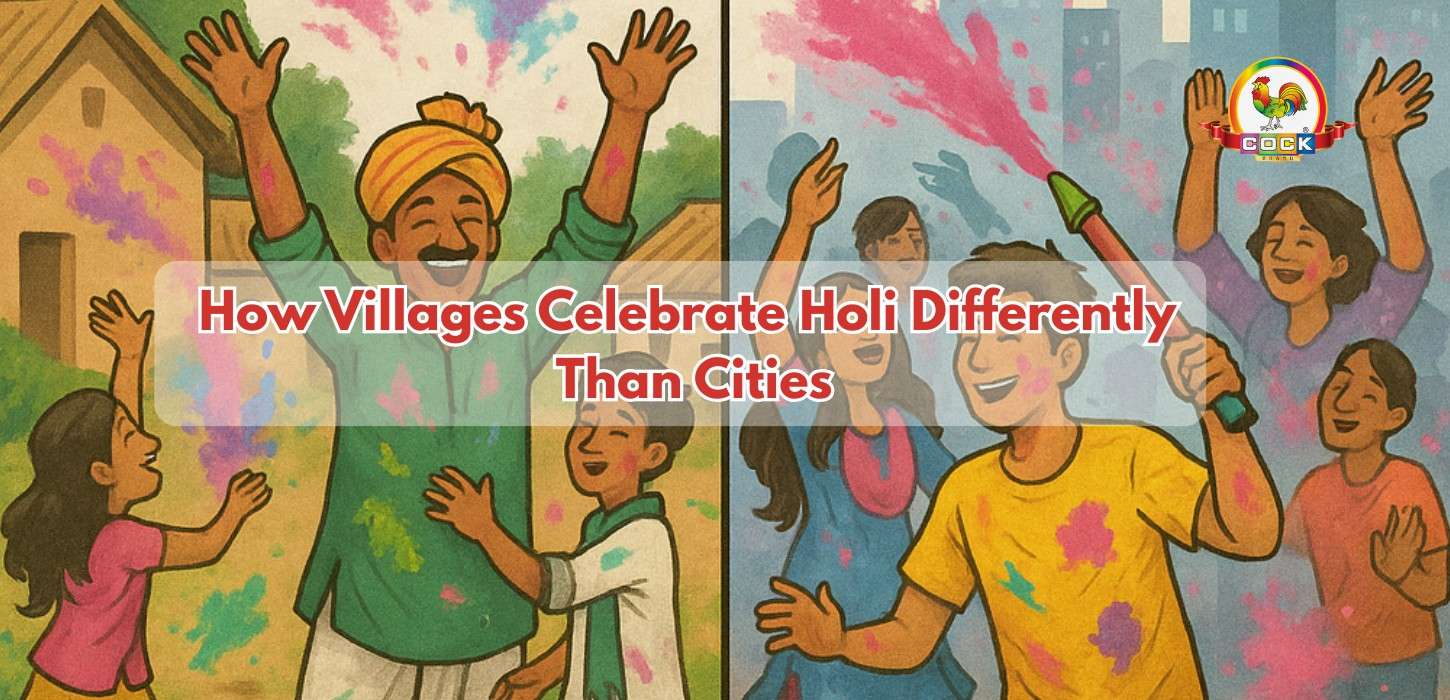


Holi is not just a festival in India; it is an emotion. It brings together communities, colours the hearts with joy, and spreads laughter across age groups. But if you travel from the hustle-bustle of metro cities to the peaceful lanes of rural India, you’ll find a stark difference in how Holi is celebrated. The Holi celebration in villages is rooted in tradition, simplicity, and a sense of collective community. On the other hand, Holi in cities is more modern, often influenced by lifestyle changes, private parties, and sometimes even loud music events.
From the types of gulal used to the way rituals are followed, this blog explores the beautiful contrasts in how villages and cities observe this joyful festival of colours.
In Indian villages, Holi is a community affair. It begins days before with people gathering firewood for Holika Dahan. Every house contributes to this, showing the strong bond of unity. After the fire ritual, villagers smear organic Holi colours on each other, sing folk songs, and play traditional drums like dholak and nagada.
Everyone participates—whether it's the elderly or the youngest child.
Lathmar Holi, Braj Holi, and Phoolon wali Holi are celebrated with cultural pride.
Home-cooked sweets like gujiya and malpua are shared door to door.
In contrast, Holi in cities has turned into more of a private celebration. Families often stay indoors or join gated society functions.
Water balloons and pichkaris are replaced by artificial snow sprays and DJ parties.
Most celebrations are planned in parks or clubs.
Community bonding is often limited to a few neighbours or friends.
People in villages have largely preserved their connection with nature. Traditionally, villagers make natural colours at home using flowers like palash or ingredients like haldi and chandan.
These Organic Holi colours are skin-friendly and biodegradable.
They are made with flowers, turmeric, and herbs.
Often dried and ground at home with care and purity.
In cities, people buy ready-made colour powders. While many are now switching to organic gulal, cheaper chemical-based powders still exist in the markets.
Harmful chemicals may lead to skin irritation or allergies.
Brands like Cock Colours now offer safe, herbal Holi colours to bridge this gap.
Cities are catching up with the idea of celebrating responsibly.
In villages, Holi celebration starts with traditional songs like Hori, bhajans, and long night-time gatherings. The Holika Dahan ritual is performed with great devotion, symbolising the victory of good over evil.
Temples are the centre point of all gatherings.
Folk performances like Raaslila and dance dramas are common.
Cultural stories related to Krishna and Radha are told to children.
City celebrations are often restricted to the holiday itself, with rituals sometimes skipped or done in smaller setups.
Holika Dahan might be organised by local Resident Welfare Associations.
Focus is more on entertainment—dance, DJ, and food stalls.
Devotional or cultural aspects take a back seat.
In villages, Holi is played in open fields or near chaupals. With fewer pollutants and use of herbal gulal, the celebration is closer to nature.
Less use of water, mostly dry Holi with organic colours.
The setting is clean and often eco-conscious.
Urban Holi often includes water balloons, synthetic colours, and single-use plastic items, which increase pollution.
Water wastage is a concern.
Post-Holi cleaning in public spaces is a challenge.
This has led to a rise in eco-Holi campaigns promoted by brands like Cock Colours.
Traditional instruments like dholak, manjira, and bansuri rule the soundscape in village Holi. People dance to folk tunes in groups, often improvising lyrics.
Songs narrate mythological stories.
No speakers, no DJs—just raw, real music from the heart.
Urban celebrations are dominated by DJs and Bollywood music.
Pre-Holi parties with rain dance are common.
Less emphasis on cultural songs, more on commercial music.
While both are safer than chemical colours, organic gulal is a more eco-conscious and certified choice. Cock Colours proudly offers both herbal and organic options to suit different preferences.
In rural India, Holi is not just about friends or relatives. Even strangers are included in the celebration. The spirit is inclusive and generous.
Social barriers blur.
Elders bless the young; neighbours forget old disputes.
In cities, people usually celebrate Holi with their inner circle—family, friends, or office colleagues.
Less interaction with the wider community.
Some even prefer not playing Holi due to privacy or skin concerns.
Holi remains a beloved festival, whether you experience it under the starry sky of a remote Indian village or inside a high-rise society in a bustling metro city. But the essence of Holi—love, unity, colour, and joy—remains unchanged.
What sets village Holi apart is its deep cultural root, natural surroundings, and the use of traditional, organic colours. The cities, however, bring in modern conveniences and creative ways to celebrate, including eco-friendly options and organised community events.
But in both settings, one thing is becoming clear: people are now more aware of the need for safe, sustainable Holi powders. That’s where Cock Colours steps in.
✅ 100% Organic Holi Colours – Crafted using flowers, turmeric, and safe ingredients.
✅ Herbal Gulal Range – Mildly scented, gentle on skin, and vibrant.
✅ Eco-Friendly Packaging – Because the planet matters.
✅ Trusted by Families and Communities – Be it village Holi or urban parties, our colours spread smiles.
This Holi, whether you're dancing in a city DJ party or playing phagwa under a neem tree in your village, choose Cock Colours to make your celebration safe, beautiful, and memorable.
Celebrate with colours that care. Celebrate with Cock Colours.
